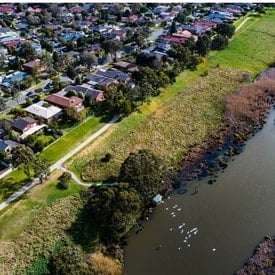
As cities and urban landscapes expand across the globe, water resource management continues to pose a huge challenge. Natural wetlands are often built over as cities grow, but a recent strategy of green infrastructure applies the opposite principle – wetlands are protected and constructed as part of city planning.
Wetlands, whether natural or man-made, act as large-scale storage and filtration centers for water streams. Beyond providing a habitat for wildlife and greenery in otherwise urban landscapes, they can remove many harmful contaminants from water, including heavy metals, excess nutrients, pesticides, and bacteria.1
Wetlands can improve an area’s resilience to extreme weather by storing excess flood water. For example, the Staten Island Bluebelt Project created 400 acres of freshwater wetlands that resolved seasonal flooding issues and saved New York City the $300 million it would have required to accomplish this by constructing storm sewers.2 In the Wade Park Wetland off the coast of North Carolina, a study indicated that up to 75% of storm runoff was being retained in this system and that an average 2-log reduction in fecal coliform load was achieved.3
Growing cities have the opportunity to integrate wetlands into sustainable water management systems. Protecting and expanding the presence of these habitats will help ensure future generations benefit from their ecological, economic, and aesthetic value.
References:
[1] “The Case for Green Infrastructure: Joint-Industry White Paper” The Nature Conservancy with Dow, Swiss Re, Shell, and Unilever Companies.
[2] “The Staten Island Bluebelt: A Study in Sustainable Water Management”. The Cooper Union.
[3] Buranen M. “Green Infrastructure Helps Coastal Wetlands” Forester Network.


![Join Sterlitech at BIO 2024 [Booth #5558]: Exploring the Future of Biotechnology](https://www.sterlitech.com/media/magefan_blog/b4.jpeg)

